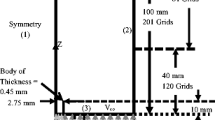Abstract
Premixed conical CH4-air flames were studied experimentally and numerically under normal straight, reversed gravity conditions and microgravity. Low-gravity experiments were performed in Drop tower. Classical Bunsen-type burner was used to find out features of gravity influence on the combustion processes. Mixture equivalence ratio was varied from 0.8 to 1.3. Wide range of flow velocity allows to study both laminar and weakly turbulized flames. High-speed flame chemoluminescence video-recording was used as diagnostic. The investigations were performed at atmospheric pressure. As results normalized flame height, laminar flame speed were measured, also features of flame instabilities were shown. Low- and high-frequency flame-instabilities (oscillations) have a various nature as velocity fluctuations, preferential diffusion instability, hydrodynamic and Rayleigh-Taylor ones etc., that was explored and demonstrated.








Similar content being viewed by others
References
Aksenov, A.A.: Flowvision: industrial computational fluid dynamics. Comput. Res. Model. 9(1), 5–20 (2017)
Bates, L., Bradley, D., Gorbatenko, I., Tomlin, A. S.: Computation of methane/air ignition delay and excitation times, using comprehensive and reduced chemical mechanisms and their relevance in engine autoignition. Combust. Flame 185, 105–116 (2017)
Bhatia, P., Singh, R.: Effect of oxygen enrichment in propane laminar diffusion flames under microgravity and earth gravity conditions. Microgravity Sci. Technol. 29(3), 177–190 (2017)
Bhowal, A. J., Mandal, B. K.: A computational study of soot formation in methane air co-flow diffusion flame under microgravity conditions. Microgravity Sci Technol 28(4), 395–412 (2016)
Bhowal, A. J., Mandal, B. K.: Numerical simulation of transient development of flame, temperature and velocity under reduced gravity in a methane air diffusion flame. Microgravity Sci. Technol. 29(1–2), 151–175 (2017)
Chen, Z.: On the accuracy of laminar flame speeds measured from outwardly propagating spherical flames: methane/air at normal temperature and pressure. Combust. Flame 162(6), 2442–2453 (2015)
Cheng, R.K., Johnson, M.R., Greenberg, P.S., Wernet, M.P.: Field effects of buoyancy on lean premixed turbulent flames. In: Proceedings of Seventh International Workshop on Microgravity Combustion and Chemically Reacting Systems Rev, vol. 1, pp 221–224 (2003)
Dreyer, M.: The drop tower Bremen. Microgravity Sci Technol 22(4), 461–461 (2010)
Guahk, Y. T., Lee, D. K., Oh, K. C., Shin, H. D.: Flame-intrinsic Kelvin–Helmholtz instability of flickering premixed flames. Energy Fuels 23(8), 3875–3884 (2009)
Kee, R.J., Grcar, J.F., Smooke, M.D., Miller, J.A.: Sandia National Laboratory Report SAND85-8240 (1985)
Kono, M., Ito, K., Niioka, T., Kadota, T., Sato, J. I.: Current state of combustion research in microgravity. Symp. (Int.) Combust. 26(1), 1189–1199 (1996)
Kostiuk, L. W., Cheng, R. K.: The coupling of conical wrinkled laminar flames with gravity. Combust. Flame 103(1–2), 27–40 (1995)
Krikunova, A. I., Son, E. E.: Effect of gravity on premixed methane–air flames. High. Temp. 1–8. https://doi.org/10.1134/S0018151X18010236 (2018)
Krikunova, A. I., Son, E. E., Saveliev, A. S.: Premixed conical flame stabilization. J. Phys.: Conf. Ser. 774(1) (2016)
Law, C. K., Faeth, G. M.: Opportunities and challenges of combustion in microgravity. Prog. Energy Combust. Sci. 20(1), 65–113 (1994)
Prud’Homme, R., Legros, G., Torero, J. L.: Combustion in microgravity: the French contribution. C.R. Mec. 345(1), 86–98 (2017)
Reimann, J., Will, S.: Optical diagnostics on sooting laminar diffusion flames in microgravity. Microgravity Sci. Technol. 16(1–4), 333–337 (2005)
Reimann, J., Kuhlmann, S. A., Will, S.: Investigations on soot formation in heptane jet diffusion flames by optical techniques. Microgravity Sci. Technol. 22(4), 499–505 (2010)
Ronney, P. D., Wachman, H. Y.: Effect of gravity on laminar premixed gas combustion I: Flammability limits and burning velocities. Combust. Flame 62(2), 107–119 (1985)
Ross, H. D. (ed.): Microgravity Combustion: Fire in Free Fall. Academic, New York (2001)
Sharp, L., Dietrich, D., Motil, B.: Microgravity fluids and combustion research at NASA Glenn Research Center. J. Aerosp. Eng. 26(2), 439–450 (2013)
Shepherd, I. G., Cheng, R. K., Day, M. S.: The dynamics of flame flicker in conical premixed flames: an experimental and numerical study. Lawrence Berkeley National Laboratory (2005)
Son, E. E., Krikunova, A. I., Saveliev, A. S.: Premixed combustion study: turbulence in the nozzle behind grids and spheres. High. Temp. 54(3), 403–408 (2016)
Wang, Y., Lei, Y., Zhang, X., Hu, W., König, J., Hinrichs, O., Eigenbrod, C, Rath, H.: Buoyancy influence on wrinkled premixed V-flames. Microgravity Sci. Technol. 13(1), 8 (2001)
Wang, Y., König, J., Eigenbrod, C.: Effects of buoyancy on open turbulent lean premixed methane-air V-flames. Microgravity Sci. Technol. 14(3), 25–37 (2003)
ZARM drop tower Bremen User Manual: ZARM FABmbH University of Bremen. Bremen, April 26 (2012)
Zimont, V. L.: Damköhler-Shelkin paradox in the theory of turbulent flame propagation, and a concept of the premixed flame at the intermediate asymptotic stage. Flow Turbul Combust 97(3), 875–912 (2016)
Acknowledgements
The authors would like to thank K.V. Klinkov and C. Eigenbrod for their help in performing experiments under microgravity conditions.
The experimental work has been supported by the German Aerospace Center (DLR) Office for Research under Space Conditions under Grant No. 50WM1125 within the project: “Droplet-Droplet Interactions” which is gratefully acknowledged.
The treatment and analysis of experimental results work was supported by the Ministry of education and science of the Russian Federation within the framework of the research activities on the subject of “Investigation of electrophysical and thermal processes in multiphase and reactive environments”, state registration number AAAA-A-16-116051810083-4.
Author information
Authors and Affiliations
Corresponding author
Additional information
This article belongs to the Topical Collection: Non-Equilibrium Processes in Continuous Media under Microgravity
Guest Editor: Tatyana Lyubimova
Rights and permissions
About this article
Cite this article
Krikunova, A.I., Son, E.E. Premixed Flames Under Microgravity and Normal Gravity Conditions. Microgravity Sci. Technol. 30, 377–382 (2018). https://doi.org/10.1007/s12217-018-9607-8
Received:
Accepted:
Published:
Issue Date:
DOI: https://doi.org/10.1007/s12217-018-9607-8




